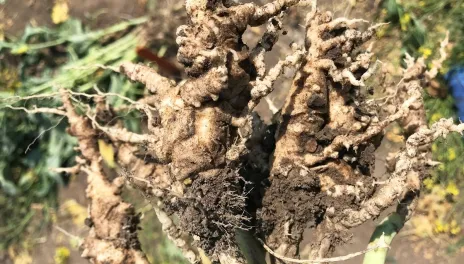NDSU Researchers Monitor the Spread of Clubroot of Canola
North Dakota leads the U.S. in canola production, producing 1.5 to 1.7 million acres each year. With such high production rates, canola is a major contributor to the state’s economy.
When canola diseases threaten production, North Dakota farmers face significant losses.
Clubroot on canola is an emerging canola disease that was first identified in North Dakota in 2013. This soil-borne pathogen moves from field to field, traveling on both agricultural and non-agricultural equipment.
“In simple words, the pathogen moves on whatever moves the soil,” says Venkat Chapara, research plant pathologist at the Langdon Research Extension Center. “Then, it can live in the soil for more than 17 years.”
Managing clubroot requires an integrated approach that includes sanitizing equipment, longer crop rotations and the use of resistant cultivars. However, the only practice widely adopted by farmers is the use of resistant cultivars.
Because restricting the movement of the pathogen is a key strategy in clubroot management, NDSU plant pathologists set out to determine the prevalence of clubroot in North Dakota. Over the years following its identification in Cavalier County, they conducted annual surveys focused on examining canola roots for clubs or galls.
In 2020, the survey went statewide and incorporated soil samples to determine the presence and amount of clubroot resting spores per gram of soil. While the surveys only found visual gall roots on the canola crop grown in Cavalier County, they found clubroot resting spore DNA in field soil samples collected from 41 of the 50 counties surveyed in the past two years. Over half of those counties had soil samples with more than 80,000 spores per gram of soil, the threshold at which canola will develop symptoms of clubroot if the soil is acidic and the canola variety is susceptible.
“This data indicates that there is a need for continuous annual monitoring for clubroot in North Dakota,” says Chapara.
FOR MORE INFORMATION:
https://www.ag.ndsu.edu/langdonrec/archive/field-crop-disease-research/canola-1/canola-new
Venkata Chapara, (701) 253-2582, venkata.chapara@ndsu.edu

